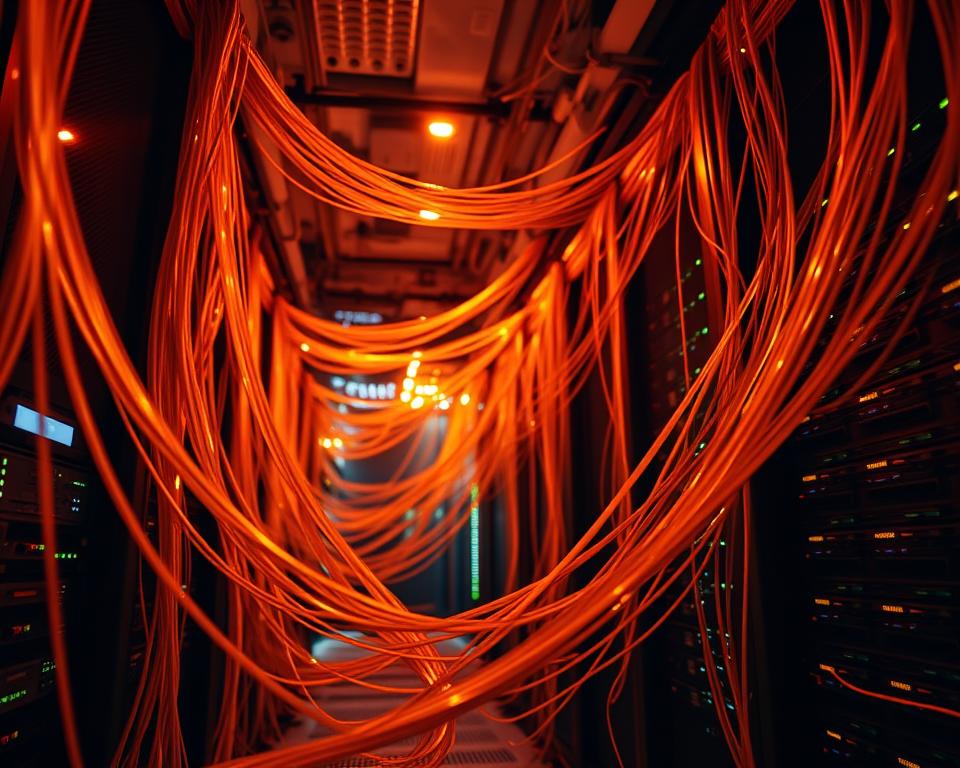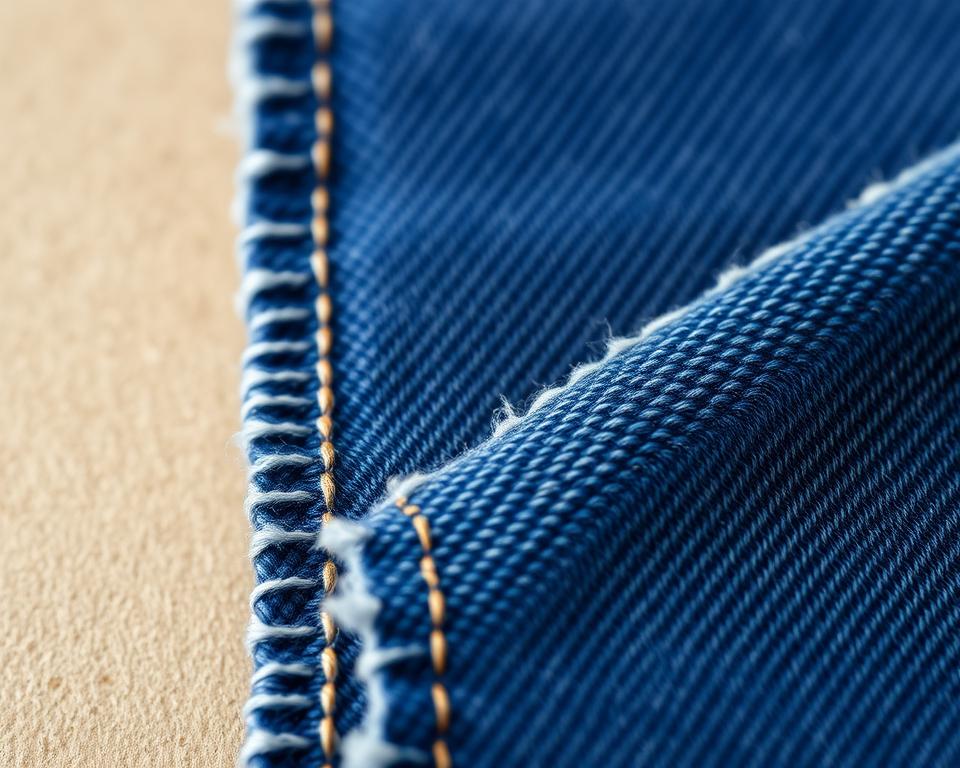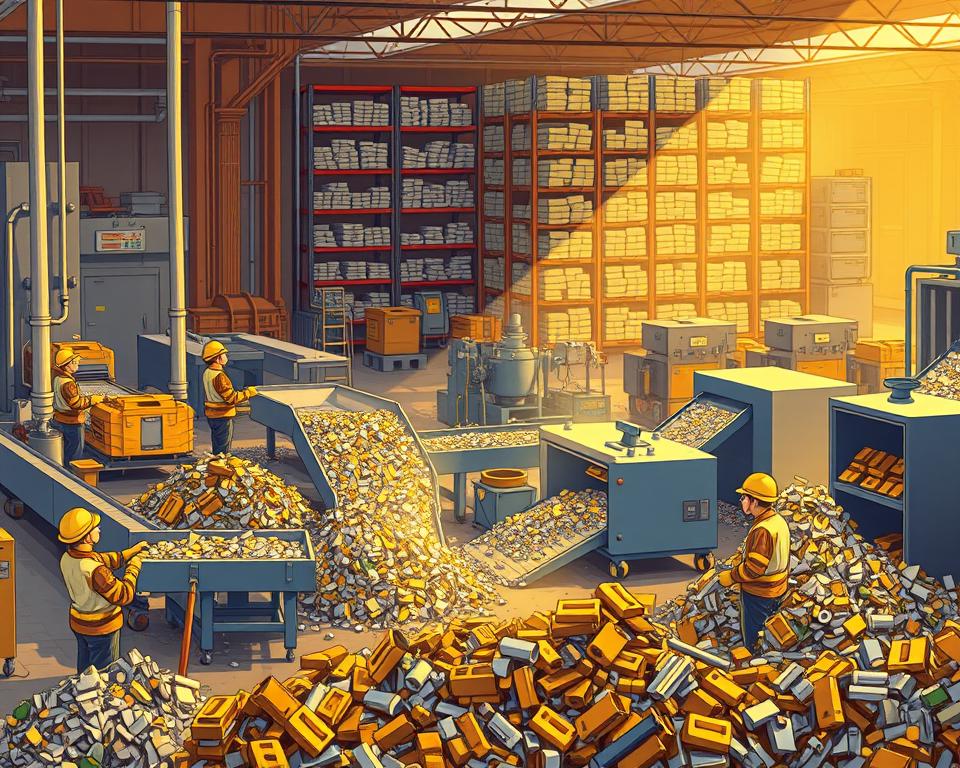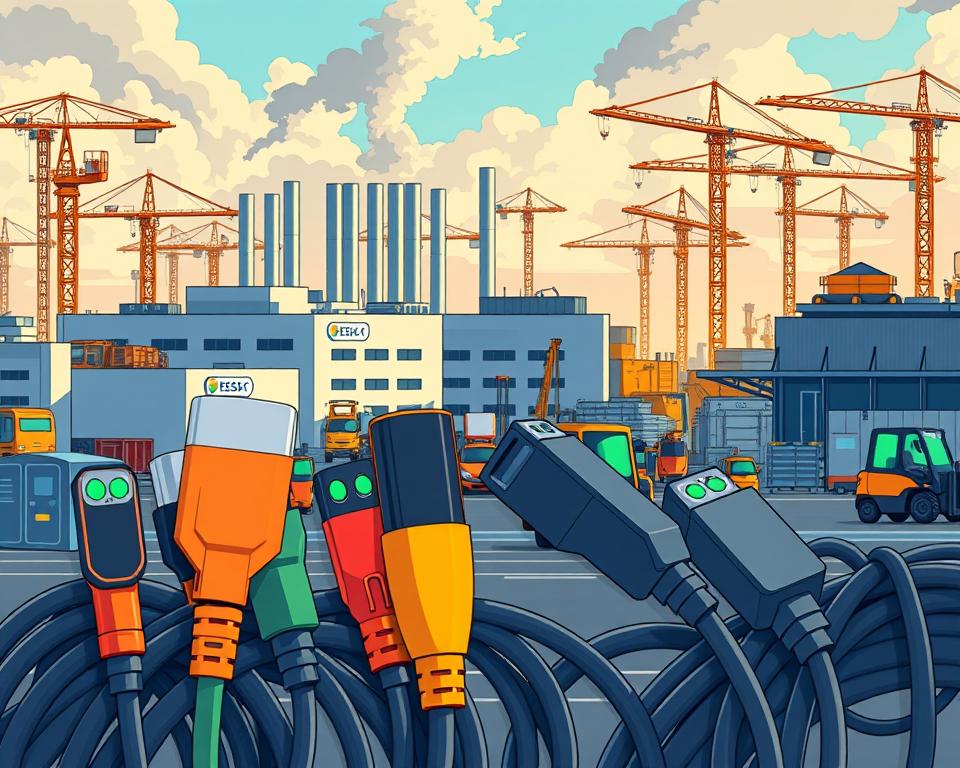Looking Forward: Fiber Optic Data Transfer Technology
Did you know a single hair-thin strand can now carry over 100 terabits of data per second? That’s enough to stream 12 million HD movies simultaneously—quite a jump compared to the 1950s, when researchers began using light for rudimentary signaling.
- Data speeds a hundredfold greater than legacy copper cables
- Zero interference from power lines or radio signals
- Capacity to support 5G networks and 8K streaming
| Feature | Copper Cables | Fiber Optic Cables |
|---|---|---|
| Speed | 10 Gbps max | Exceeding 100 Tbps |
| Range | 100 meters | 70+ kilometers |
| Security | Prone to tapping | Highly resistant to eavesdropping |
Optical signals reflect within glass cores via total internal reflection, like a laser ricocheting through a mirrored tunnel. This physics trick prevents signal loss, even over continental distances. With growing video conferencing and IoT devices, these fibers prevent network overloads – SZ stranding line.
The Development Path of Fiber Optic Communications
Decades of innovation transformed light-based data transfer from theory to reality. Researchers in the 1950s discovered that glass strands could guide light—a concept that reshaped modern connectivity.

Pioneers and Initial Trials
Narinder Singh Kapany made history in 1952 by proving light could travel through bent glass. His work coined the term “fiber optics” and laid the foundation for today’s networks. Alongside Harold Hopkins, he developed flexible imaging bundles that later inspired data transmission methods.
By the 1960s, laboratory trials showed these fibers had real-world applications. Although initial implementations suffered loss, ongoing experiments improved their efficiency. Engineers realized purified glass cores could carry light pulses farther without distortion.
Milestones in Fiber Development
In the 1970s, the first commercial deployments revolutionized the industry. Telephone companies adopted cables that replaced copper lines, boosting call clarity and capacity. Corning Glass Works achieved a critical breakthrough in 1970—low-loss optical fiber that could transmit signals over 65 kilometers.
| Date | Achievement | Significance |
|---|---|---|
| 1977 | Initial live telephone transmissions | Proved real-world reliability |
| 1988 | Launch of TAT-8 transatlantic link | Connected continents |
| 1990s | Introduction of erbium-doped fiber amplifiers | Enabled long-distance networks |
Modern advancements focus on speed and scalability. DWDM technology multiplexes many channels on one fiber concurrently. Such progress connects laboratory research to worldwide network infrastructures.
Fundamentals of Fiber Optic Communication Technology
Light travels faster than anything else—so why not use it to send messages?. This simple idea powers modern networks. Rather than electrons in metal cables, photons traverse geographic barriers. Here’s how it works.
Photons vs. Electrons: Why Light Wins
Light pulses carry information more efficiently than electricity. Light particles:
- Move at 186,000 miles per second (99.7% light speed)
- Don’t create heat or electromagnetic interference
- Can carry multiple signals at once using different wavelengths
| Criterion | Electrons (Copper) | Photon Signaling (Fiber) |
|---|---|---|
| Speed | Up to 10 Gbps | 100+ Tbps |
| Noise Susceptibility | Affected by power lines | Unaffected by EMI |
| Energy Use | Greater energy demand | Lower energy requirement |
Total Internal Reflection in Fiber Cores
Photons remain confined within the fiber’s core by total internal reflection. The core has a higher refractive index than the surrounding cladding. When light hits the boundary at a steep angle, it bounces back like a mirror, staying on course for miles.
This design prevents signal loss. Over extensive spans, nearly 95% of photons arrive intact. Combined with laser precision, it ensures your video calls stay crisp and your downloads finish fast.
Different Types of Fiber Optic Cables
Not all glass strands are created equal. The right cable type depends on how far your data needs to travel and how much information you’re sending. Below are the two primary classifications and their distinct features.
| Feature | SMF | MMF |
|---|---|---|
| Core Diameter | ~9 microns | 50–62.5 µm |
| Bandwidth | >100 GHz | ~35–500 MHz |
| Max Distance | 120 miles | ~1,600 ft |
| Typical Applications | Telecom networks | Local area networks |
Hospitals use single-mode for MRI image transfers between buildings. Schools often pick multi-mode for classroom networks—it handles video streams without breaking budgets. Both types keep our world connected, just in different ways.
Fiber Optic Cable Construction and Key Components
Ever wondered what keeps your internet running smoothly during a storm The answer lies in the smart design of modern cables. These high-tech threads use multiple layers to protect data while traveling at light speed.
Core, Cladding & Coating Explained
At the heart of every cable sits the glass core—thinner than a human hair. This pure glass guides photons via total internal reflection. The cladding layer, with a lower refractive index, reflects stray light back into the core.
An acrylate polymer coating encases the cladding and core. This ~250 µm barrier safeguards against physical abrasions and water ingress. Collectively, these layers create the optical conduit for data.
Armoring and Outer Protection
Real-world durability comes from Kevlar® strands around the coated core. These aramid fibers absorb tension during installation, preventing breaks when pulling cables through conduits. A PE jacket atop resists environmental hazards, chemicals, and rodent gnawing.
| Component | Material | Role |
|---|---|---|
| Central Glass | Pure silica glass | Light transmission |
| Surrounding Glass | Doped silica | Signal containment |
| Polymer Layer | Acrylate polymer | Physical protection |
| Jacket | Polyethylene | Environmental shield |
Color coding matters too—orange jackets denote multi-mode cables, while yellow marks single-mode versions. This simple system helps technicians quickly identify cable types during installations or repairs.
Working Principles Behind Data Transmission
What enables near-light-speed data transfer with minimal loss? It involves converting electrical pulses into controlled optical bursts. Flashes map bits (1s) and dark intervals (0s), forming an optical binary stream deciphered by lasers.
Photon-Based Signaling
Lasers fire 500 million light pulses per second through glass pathways. Advanced FTTH cable production line techniques like QAM-16 pack 4 bits into each flash, quadrupling capacity. This photon dance happens with near-zero electromagnetic interference, unlike older copper-based systems.
Managing Dispersion & Attenuation
Two main challenges disrupt flawless transmission:
- Chromatic dispersion: Various wavelengths travel at dissimilar velocities.
- Modal dispersion: Light paths scatter in multi-core cables.
Today’s fibers address these with these solutions:
| Remedy | Effect | Improvement |
|---|---|---|
| Specialized core doping | Equalizes wavelength speeds | 40% less signal spread |
| DSP units | Real-time error correction | 99.999% accuracy |
Signal loss drops to 0.15 dB/km in premium cables—a 92% reduction from early designs. Paired with EMI-resistant layers, they preserve signal fidelity worldwide. Consequently, transoceanic calls remain sharp despite severe weather.
Advanced Concepts in Optical Fiber Networking
What keeps your video calls from freezing during a storm The answer lies in specialized connectors and precision installation methods that form the backbone of modern networks. These components ensure seamless data flow across cities and continents.
Connectors and Splicing Techniques
Network reliability starts with proper connections. SC connectors snap into place with push-pull ease, while LC types save space in crowded server racks. MPO/MTP assemblies group fibers for bulk connections, ideal for hyperscale facilities.
Two splicing methods dominate the field:
- Fusion splicing: Melts glass ends together for near-zero signal loss.
- Mechanical splicing: Aligns fibers with precision sleeves for quick repairs.
| Connector | Ideal Use | Insertion Loss |
|---|---|---|
| SC | Enterprise networks | 0.25 dB |
| LC | High-density devices | 0.20 dB |
| MPO | Data center interconnects | ~0.35 dB |
Contemporary Network Architectures
Modern designs require adaptable deployment methods. Micro-duct systems permit cable blowing; armored jackets resist severe environments. Municipal implementations route fiber to traffic systems and surveillance, enabling intelligent networks.
Telecom operators roll out hybrid assemblies, merging electrical and optical conductors. Such designs feed 5G small cells and IoT sensors alike, showcasing agile network evolution.
Bandwidth and Throughput Advantages
Imagine data as water in pipes: larger pipes yield greater flow. This bandwidth concept explains why modern networks need glass-based systems. While copper resembles a garden hose, fiber performs like a high-capacity firehose.
- Light signals traveling at 186,000 miles per second
- Multiple data streams via wavelength multiplexing
- Error correction reducing resend requests by 80%
| Decade | Max Speed | Cost per GB |
|---|---|---|
| 1980s | 45 Mbps | Approximately \$1,200 |
| 2000s | 10 Gbps | ~\$0.12 |
| 2020s | 178 Tbps | ~\$0.0004 |
Bandwidth directly impacts what we can do online. Video calls require ~5 Mbps each; VR needs ~50 Mbps. NEC’s 2023 analysis found fiber nets serve ~40× more subscribers than copper at ~50% lower power consumption.
“Every dollar invested in high-capacity networks yields $3.80 in economic growth through improved productivity.”| “Each \$1 poured into high-bandwidth infrastructure returns \$3.80 in productivity gains.”
Performance improvements also slash operational costs. Signals travel 60 miles without repeaters versus copper’s 3,000-foot limit. Such efficiency powers 8K UHD, live AI tasks, and uninterrupted cloud sync at modest subscription fees.
Overcoming Interference and Signal Loss in Fiber Systems
Ever tried making a call during a thunderstorm only to hear static Traditional copper lines struggle with such interference. Optical fibers shrug off such noise. These cables use light instead of electricity, making them immune to electromagnetic noise from power lines, radios, or even lightning strikes.
Built-In Noise Cancellation
While copper acts as an antenna, fiber is non-conductive. Hence, optical networks remain unaffected by external interference. A 2023 study found 92% fewer data errors in industrial settings when using light-based systems compared to older methods – FTTH cable production line.
Engineers combat signal loss through three key strategies:
- High-purity cores minimize photon scattering
- Precision laser alignment minimizes power waste
- Protective coatings prevent moisture damage
| Metric | Copper | Glass-Based |
|---|---|---|
| Interference Risk | High | None |
| Signal Loss per Mile | ~3 dB/mi | ~0.2 dB/mi |
| Service Frequency | ~Monthly upkeep | Annual inspections |
“Our factory’s error rates dropped 80% after switching to light-based networks—no more machine downtime from radio interference.”| “After switching to fiber, error rates fell by 80%, eliminating downtime from RF noise.”
These cables thrive where others fail. Subsea installations withstand saltwater corrosion, while desert networks endure sandstorms without signal degradation. Boasting ~99.995% reliability, they power essential infrastructures globally.
Fiber Optics in Telecommunications and Internet Connectivity
How does your Netflix show arrive instantly from across the globe Fiber networks serve as the neural pathways of today’s Internet. They enable streaming, financial transactions, and more, using light to span oceans and landmasses.
Role in Long-Haul and Metro Networks
Undersea fibers run ~750,000 mi, handling ~99% of intercontinental data. Urban rings use these fibers to connect cell sites and corporate hubs. Optical transmitters modulate light; receivers demodulate at endpoints.
| Attribute | Copper Infrastructure | Fiber Infrastructure |
|---|---|---|
| Speed | ~1 Gbps | ~100 Tbps |
| Latency | ~5 ms per km | ~0.005 ms per km |
| Reliability | 99.9% | ~99.995% |
Data Center & Cable Television Uses
Within data centers, fibers enable rack-to-rack transfers, shifting petabytes each day. Cable providers deliver 4K content through hybrid fiber-coaxial systems. After Verizon’s 2023 fiber rollout, buffering issues dropped by ~73%.
Economic incentives accelerate uptake:
- 60% lower maintenance costs than copper
- Easily scalable for 5G traffic
- 40% energy savings per data unit
From Manhattan’s financial district to Pacific submarine routes, these communication systems prove that speed and reliability can coexist. In the words of an engineer: “Nothing outpaces light when transferring vast datasets.”
Next-Generation Fiber Innovations
Imagine networks accommodating 8 billion simultaneous video streams. Upcoming breakthroughs promise to redefine data mobility. Advanced transceivers and modulation schemes drive network evolution.
Next-Gen Transmitters & Detectors
State-of-the-art lasers output ~200 channels concurrently, compared to ~40 ten years prior. They deliver ~5× the output at ~30% reduced consumption. Combined with graphene-based photoreceivers, they detect even minimal photon levels.
Key breakthroughs include:
- Narrow-linewidth lasers reducing noise by 90%
- Photonics-integrated circuits shrinking hardware size
- AI-driven calibration maintaining peak performance
Coherent Optics & Multiplexing
Coherent systems treat light like radio waves, encoding data in its phase and amplitude. This trick boosts capacity 16-fold compared to older on-off signaling. Coupled with WDM, fibers can transport over 800 channels.
| Method | Wavelengths | Speed Gain |
|---|---|---|
| DWDM | 160 | ~80 Tbps |
| OFDM | ~512 | ~120 Tbps |
| SDM | Multi-core fibers | 1 Pbps* |
*Experimental (NTT, 2023)
Such approaches mesh with current networks with minimal overhaul. Verizon’s 2024 upgrade used coherent tech to double network capacity without laying new cables. An engineer remarked: “Repurposing legacy fibers with coherent methods unlocks untapped potential.”
Global Standards and Design Considerations
Ever wondered how your video call stays crystal clear across continents Global standards act as invisible rulebooks, ensuring every piece of the puzzle works perfectly together. Absent these specs, infrastructure would face mismatches and inefficiencies.
| Specification | Focus Area | Impact |
|---|---|---|
| ITU G.652 | Single-mode fiber | Enables 100Gbps+ speeds |
| IEC 60793-2-50 | Mechanical reliability | Ensures 20-year lifespans |
| ITU G.654 | Subsea cables | Prevents saltwater corrosion |
Performance Metrics and Quality Assurance
Consistent testing keeps networks running smoothly. Key benchmarks include signal loss (under 0.25 dB/km) and tensile strength (minimum 50 Newtons). Vendors conduct over 200 quality tests, including thermal and bend stress trials.
“Our compliance with IEC 61300-3-35 reduced installation errors by 65% last year.”| “Adhering to IEC 61300-3-35 led to a 65% drop in deployment mistakes.”
Certified parts and precise specs avert expensive rework. Technicians rely on uniform color schemes and termination practices to link heterogenous gear flawlessly. Such uniformity preserves uninterrupted global data exchange.
Real-World Fiber Deployment Examples
How can metropolises support massive concurrent streaming demands? Real-world deployments show how smart planning and advanced cables keep our digital world running smoothly. Below are two landmark implementations that transformed worldwide networking.
Urban Deployments and Metro Networks
NYC’s Metro Fiber initiative addressed slow copper infrastructure, which hindered business connectivity by ~40%. They laid 800 mi of micro-trenched fiber beneath sidewalks, steering clear of subways and utilities. Outcomes: Latency fell from ~14 ms to ~2 ms; throughput increased by ~600%.
| Issue | Approach | Outcome |
|---|---|---|
| Subsoil crowding | 3D GIS route planning | 92% faster installation |
| Signal interference | Armored multi-core cables | ~99.99% reliability |
| Funding limits | Public-private partnerships | 30% cost reduction |
Underwater & Cross-Ocean Deployment
The MAREA cable—stretching 4,000 miles between Virginia and Spain—handles 160 Tbps across eight fiber pairs. Installation crews faced 10,000-foot depths and shark bites, using robotic subs to bury strands in seabed sediment. This $160 million project now carries 55% of Europe-North America traffic.
“Subsea systems require 200+ design revisions before deployment. Every meter matters when you’re laying cable across tectonic plates.”| “Over 200 design iterations are typical for undersea cables. Small changes hugely impact viability across plates.”
Differences by deployment scenario:
- City installations prefer bend-insensitive fiber for tight paths
- Subsea systems require titanium-reinforced sheathing
- Remote installations leverage solar-powered repeaters
Either method shows how sound engineering and robust materials revolutionize data transport. From Manhattan’s skyscrapers to Atlantic ocean floors, these networks form the silent backbone of modern life.
Fiber Economics & Growth Potential
What fuels today’s streaming surge and telecommuting trend? The answer lies in networks that combine upfront investment with long-term savings. While initial deployment costs can reach \$60,000 per mile, these systems deliver unmatched value over decades of service.
Strategic Investment for Scalability
Upgrading to advanced networks cuts operational costs by 40% compared to copper systems. Maintenance expenses drop sharply—no more replacing corroded wires or fighting electromagnetic interference. A 2024 study showed:
| Cost Factor | Legacy Systems | Fiber-Based |
|---|---|---|
| Installation | \$45/meter | \$28/meter |
| Energy Use | 5W per device | 1.2W per device |
| Service Calls | 12/year | 2/year |
Global investment trends confirm this shift. Telecom giants plan to spend \$150 billion through 2027 expanding infrastructure. Urban projects now achieve 300% ROI within five years through increased productivity and reduced downtime.
Overcoming Rollout Challenges
Yet municipalities encounter three primary obstacles:
- Permit processes can extend schedules by ~18 months
- Labor shortages in specialized installation crews
- Public resistance to street excavations
“Our Phoenix deployment took 22 months instead of 14 due to permit bottlenecks. Still, the network boosted local GDP by \$380 million annually.”| “Phoenix’s build required ~22 months, not 14, over permit delays—but delivered ~\$380M/year in GDP uplift.”
Novel remedies appear. Micro-trenching reduces street disruption by 80%, while public-private partnerships share financial risks. These approaches help communities harness the power of scalable, future-ready systems without breaking budgets.
Innovations and Future Prospects in Data Transmission
Fiber backbones are receiving performance upgrades. Scientists explore sub-micron fibers and advanced modulations beyond existing standards. Such progress aims to reduce latency and accommodate future data surges.
Upcoming Fiber Innovations
MIT’s 2024 experiments suggest hollow-core fibers (air-filled) may cut latency ~30%. These tubes guide light through vacuum-like channels, reducing signal drag. Parallel multi-core fibers embed seven channels in one sheath, boosting throughput ~4×.
| Metric | Today’s Specs | Future Projection |
|---|---|---|
| Throughput | ~100 Tbps | 1.2 Pbps |
| Reach | ~70 km | 150 km |
| Energy Use | 0.5 W/device | ~0.15 W/device |
New multiplexing schemes squeeze 400 wavelengths into single strands—up from 160 today. This “spectral supercharging” lets networks handle 8K virtual reality streams without breaking stride.
Integration with 5G and Beyond
Future 6G deployments depend on high-capacity fiber rooftails for mmWave support. Dallas field tests achieved ~10 Gbps wireless throughput over robust fiber backhaul.
- 5G small cells need fiber links every 500 feet
- Satellite-ground stations require low-latency connections
- Industrial IoT setups demand real-time fiber-based data for automated systems
Nokia’s 2023 report says advanced fiber cuts 5G round-trip delay by ~82%. As one engineer noted: “Wireless needs wired bones—the faster the backbone, the smoother the airwaves.”
The Bottom Line
The unseen fibers linking our digital lives continue evolving. Material science and engineering leaps have moved us from copper constraints to optical velocity. Today’s networks prove faster isn’t just better—it’s essential for streaming, surgeries, and stock markets alike.
Modern systems thrive through smart design. Polymer coatings defend fragile cores; international specs guarantee interoperability. Such features cut power consumption ~40% versus legacy tech, rendering ultrafast access eco-friendly and expandable.
Obstacles persist—deployment expenses and community engagement. Still, ROI is strong—each \$1 spent returns ~\$4 in economic output. As 5G expands and AI demands real-time data, reliable infrastructure becomes non-negotiable.
Looking ahead, researchers aim to push boundaries further. Hollow cores and advanced wavelength methods may render current rates outdated. Undoubtedly, information exchange will advance further, fueled by our relentless drive for faster, broader, and more intelligent connectivity.


